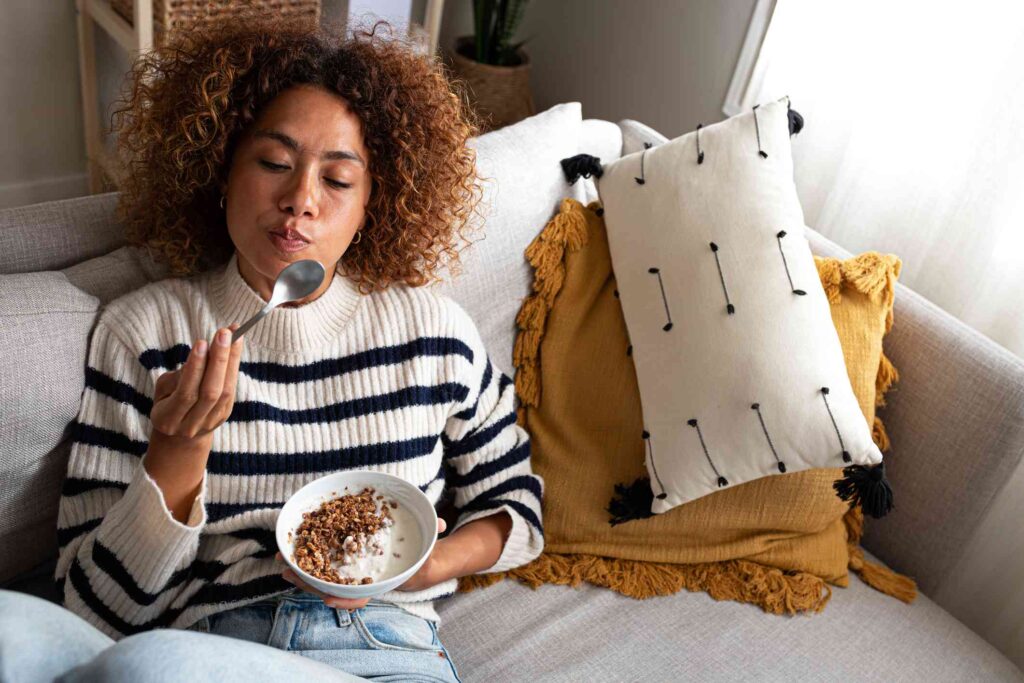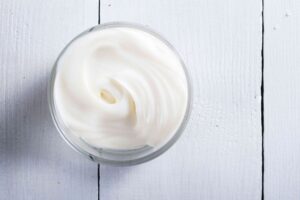:max_bytes(150000):strip_icc():format(jpeg)/Health-GettyImages-FoodsYouThinkMightBeHighInProteinButArent-110c30fa931040dabd102b935c0ed606.jpg)
Protein is needed for critical processes such as building muscle, immune response, and creating hormones and neurotransmitters. Adding protein-rich foods to meals and snacks can also support weight loss, improve your body composition, and support blood sugar regulation.
Many high-protein foods and drinks can help you meet and exceed your daily protein needs. However, some foods and drinks promoted as high in protein actually might not contain as much protein as you think.
Koval Nadiya / Getty Images
Peanut butter is a good source of several nutrients, such as vitamin E and folate. However, though it’s often considered a high-protein food, it only contains a small amount.
Peanut butter provides 8 grams of protein per 2 tablespoons (32 grams), which isn’t enough to be considered “high” in protein. The same serving packs 200 calories, so you’d need to consume several hundred calories to get a decent amount of protein from peanut butter.
Peanut butter can add a small boost of protein and other nutrients, such as healthy fats and fiber, to recipes like smoothies and toast, but it’s not the most concentrated source of protein. Consider pairing peanut butter with high-protein ingredients, like protein powders.
wilatlak villette / Getty Images
Yogurt is a popular breakfast and snack option. Though some types of yogurt are high in protein, regular yogurt isn’t the best source.
Greek yogurt is a better option if you’re trying to increase your protein intake. It provides nearly twice the amount of protein regular yogurt does. A 6-ounce container of plain, regular yogurt contains just 8.92 grams of protein, while the same serving of plain Greek yogurt contains 17.3 grams.
Greek yogurt also contains about 50% fewer carbohydrates than regular yogurt, making it a better option for those following low-carbohydrate diets.
SimpleImages / Getty Images
Many items marketed as “protein bars” or “protein bites” only contain a few grams of protein per serving.
For example, Kind PB Banana Dark Chocolate Breakfast Protein Bars contain 8 grams of protein per two-bar serving. You can more than double your protein intake by swapping these bars for a breakfast of two eggs, a piece of cheese, and some fresh fruit.
Choosing protein bars with at least 12 grams of protein per serving can help keep you full until your next meal, especially if paired with fiber-rich food like a piece of fruit. Protein and fiber support feelings of fullness by slowing digestion and increasing the production of satiety (fullness) hormones, helping reduce your overall calorie intake if that’s a goal.
Helen Camacaro / Getty Images
Smoothies are generally not a good source of protein unless they’re made with high-protein ingredients. They can also be high in added sugar.
When shopping for premade smoothies, choose products advertised as high in protein—for example, 15-30 grams of protein per 15.2-ounce serving. Read nutrition labels for other ingredients, including added sugars, and opt for fruit or other naturally-sweetened smoothies when possible.
You can make healthy, protein-packed smoothies at home by blending frozen fruit, unsweetened milk or nut milk, and a protein powder like whey protein isolate, which packs 25 grams of protein per 30-gram scoop. Pea protein and hemp protein are some plant-based options.
Elena Fedorina / Getty Images
Chia seeds are often referred to as a “superfood” due to their high levels of nutrients like fiber, magnesium, calcium, selenium, and zinc. While chia seeds are packed with many vitamins, minerals, and other protective compounds, they’re not protein-rich.
One ounce of chia seeds contains 4.68 grams of protein. Since chia seeds are typically consumed in small portions (e.g., a few tablespoons at a time), chia seeds shouldn’t be considered a high-protein food.
Although chia seeds aren’t the best source of protein, they’re an excellent source of nutrients like fiber, which is essential for digestive health, and magnesium, which is needed for blood sugar and blood pressure regulation.
Madeleine_Steinbach / Getty Images
If you’re hoping to add more protein to soups, stews, and other recipes, choosing the right broth is important. Many people think that all animal-based broths are a good source of protein, but most broths are low in this critical nutrient.
One cup of regular chicken broth contains just 3.26 grams of protein, making it a low-protein food.
Bone broth is a more concentrated and higher protein broth option. A cup of chicken bone broth contains about three times more protein than the same serving of regular chicken stock. You can use bone broth to bump up the protein content of your favorite recipes.
Westend61 / Getty Images
Granola bars are a convenient snack option that many people use as an easy snack. While granola bars typically provide carbohydrates and fiber, they’re often low in protein.
Many granola bars contain only a few grams of protein. Choosing high-protein bars, like those with at least 12 grams of protein per serving, can help you stay satiated between meals and are a much better option for blood sugar regulation.
Marina Kuttig / Getty Images
When consumed in larger amounts, chickpeas, the main ingredient in hummus, are an excellent source of protein. One cup of cooked chickpeas contains 14.5 grams of protein.
Hummus is commonly consumed in small amounts, meaning it isn’t as high in protein as some people may think. One-quarter cup of hummus provides 4.77 grams of protein, which isn’t enough to be considered a high-protein dip.
Hummus can be combined with high-protein ingredients to boost the protein content of plant-based dishes like salads.
Phamai Techaphan / Getty Images
Cow’s milk is a good source of protein, providing around 9.68 grams per cup. However, many people have stopped consuming it due to dietary preferences, health concerns, or environmental concerns.
With the exception of soy milk, most plant-based milks are low in protein. A cup of almond milk provides just over a gram of protein, while a cup of coconut milk provides none. Some plant-based milks are higher in protein, including those with added pea protein.
If you like using nut milk in your coffee drinks, you can compensate for low protein content by adding a scoop of collagen to your beverage. Collagen peptides provide around 12 grams of protein per 14-gram scoop and may benefit the health of your skin, bones, and joints.
Kinga Krzeminska / Getty Images
Quinoa is often considered high in protein because it’s higher in protein than many popular grains, like white rice. It provides 8 grams of protein per cup, while the same serving of white rice contains just 3.52 grams.
Though quinoa is higher in protein than many other carbohydrates, it should be paired with higher-protein foods, like beans, chicken, edamame, or tempeh, to create a protein-rich meal or snack.
While you may be disappointed to learn that a few of your go-to protein sources aren’t as high in protein as you’d hoped, there are plenty of high-protein foods you can pair with the items listed above to create protein-rich meals and snacks.
Here are a few high-protein foods:
- Eggs: 6.28 grams (g) per large egg
- Canned salmon: 19.6 g per 3-ounce (oz) serving
- Edamame: 18.5 g per cup
- Whey protein isolate: 25 g per 30-g serving
- Cottage cheese: 23.5 g per cup
- Chicken breast: 31.1 g per small skinless chicken breast
- Greek yogurt: 19.9 g per 7-oz serving
- Tempeh: 19.9 g per 100-g serving
- Lentils: 17.9 g per cup
- Garbanzo beans: 14.5 g per cup
Combining multiple protein sources at every meal and snack can help you meet your daily protein needs. Try using hummus as a spread on a turkey and vegetable wrap or using bone broth and Greek yogurt to add extra protein to lentil-based dishes, like curries.
While many foods are advertised as high-protein, not all are as high in protein as you may think.
Peanut butter, broth, quinoa, granola bars, smoothies, regular yogurt, and nut milks are just a few items commonly considered protein-rich that generally don’t contain high amounts of protein.
To increase your chances of meeting your daily protein needs, try combining multiple sources of protein, including plant-based and animal-based sources, at every meal and snack.













